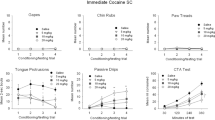Abstract
Male Sprague Dawley rats were injected daily with saline (morphine naive rats) or 20 mg/kg morphine (morphine experienced rats), starting at least 12 days before training. Subsequent place and taste conditioning indicated that 2.5 mg/kg morphine caused a significant increase in the amount of time spent on the least preferred side by morphine experienced but not by morphine naive rats; furthermore, saccharin consumption was markedly decreased and slightly increased by 10–20 mg/kg morphine in naive and experienced rats, respectively. It was concluded that morphine experience enhances the reinforcing efficacy of morphine and broadens the conditions under which the drug is reinforcing; thus it possibly increases morphine abuse potential.
Similar content being viewed by others
References
Barrett JE, Witkin JM (1986) The role of behavioral and pharmacological history in determining the effects of abused drugs. In: Goldberg SR, Stolerman IP (eds) Behavioral analysis of drug dependence. Academic Press, Orlando, Florida, pp 195–223
Bartoletti M, Gaiardi M, Gubellini C, Bacchi A, Babbini M (1983) Long-term sensitization to the excitatory effects of morphine. A motility study in post-dependent rats. Neuropharmacology 22:1193–1196
Bechara A, van der Kooy D (1985) Opposite motivational effects of endogenous opioids in brain and periphery. Nature 314:533–534
Carr GD, White NM (1986) Anatomical disassociation of amphetamine's rewarding and aversive effects: an intracranial microinjection study. Psychopharmacology 89:340–346
Oorfield-Sumner PK, Stolerman IP (1978) Behavioral tolerance. In: Blackman DE, Sanger DJ (eds) Contemporary research in behavioral pharmacology. Plenum Press, New York, pp 391–448
Goudie AJ (1987) Aversive stimulus properties of drugs: the conditioned taste aversion paradigm. In: Greenshaw AJ, Dourish CT (eds) Experimental psychopharmacology. Humana Press, Clifton, pp 341–391
Griffiths RR, Balster RL (1979) Opioids: similarity between evaluations of subjective effects and animal self-administration results. Clin Pharmacol Ther 25:611–617
Hand TH, Koob GF, Stinus L, Le Moal M (1988) Aversive properties of opiate receptor blockade: evidence for exclusively central mediation in naive and morphine-dependent rats. Brain Res 474:364–368
Jacobs WJ, Zellner DA, LoLordo VM, Riley AL (1981) The effect of post-conditioning exposure to morphine on the retention of a morphine-induced conditioned taste aversion. Pharmacol Biochem Behav 14:779–785
Johanson CE, Schuster CR (1981) Animal models of drug self-administration. In: Mello NK (ed) Advances in substance abuse: behavioral and biological research, vol 2. JAI Press, Greenwich, pp 219–297
Lett BT (1989) Repeated exposures intensify rather than diminish the rewarding effects of amphetamine, morphine, and cocaine. Psychopharmacology 98:357–362
Lett BT, Grant VL (1989) Conditioned taste preference produced by pairing a taste with a low dose of morphine or sufentanil. Psychopharmacology 98:236–239
Mansky PA (1978) Opiates: human psychopharmacology. In: Iversen SD, Snyder SH (eds) Handbook of psychopharmacology, vol 12. Plenum Press, New York, 95–185
Martin GM, Bechara A, van der Kooy D (1988) Morphine preexposure attenuates the aversive properties of opiates without preexposure to the aversive properties. Pharmacol Biochem Behav 30:687–692
McKearny JW, Barrett JE (1978) Schedule-controlled behavior and the effects of drugs. In: Blackman DE, Sanger DJ (eds) Contemporary research in behavioral pharmacology. Plenum Press, New York, pp 1–68
Mucha RF (1989) Taste aversion involving central opioid antagonism is potentiated in morphine-dependent rats. Life Sci 45:671–678
Mucha RF, Herz A (1985) Motivational properties of kappa and mu opioid receptor agonists studied with place and taste preference conditioning. Psychopharmacology 86:274–280
Mucha RF, Iversen SD (1984) Reinforcing properties of morphine and naloxone revealed by conditioned place preference: a procedural examination. Psychopharmacology 82:241–247
Reicher MA, Holman EW (1977) Location preference and flavor aversion reinforced by amphetamine in rats. Anim Learn Behav 5:343–346
Schenk S, Hunt T, Klukowski G, Amit Z (1987) Isolation housing decreases the effectiveness of morphine in the conditioned taste aversion paradigm. Psychopharmacology 92:48–51
Shippenberg TS, Emmett-Oglesby MW, Ayesta FJ, Herz A (1988) Tolerance and selective cross-tolerance to the motivational effects of opioids. Psychopharmacology 96:110–115
Stewart J, Eikelboom R (1978) Pre-exposure to morphine and the attenuation of conditioned taste aversion in rats. Pharmacol Biochem Behav 9:639–645
Stewart RB, Grupp LA (1986) Conditioned place aversion mediated by orally self-administered ethanol in the rat. Pharmacol Biochem Behav 24:1369–1375
van der Kooy D, Mucha RF, O'Shaughnessy M, Bucenieks P (1982) Reinforcing effects of brain microinjections of morphine revealed by conditioned place preference. Brain Res 243:107–117
Wise RA, Bozarth MA (1987) A psychomotor stimulant theory of addiction. Psychol Rev 94:469–492
Author information
Authors and Affiliations
Rights and permissions
About this article
Cite this article
Gaiardi, M., Bartoletti, M., Bacchi, A. et al. Role of repeated exposure to morphine in determining its affective properties: place and taste conditioning studies in rats. Psychopharmacology 103, 183–186 (1991). https://doi.org/10.1007/BF02244201
Received:
Revised:
Issue Date:
DOI: https://doi.org/10.1007/BF02244201




